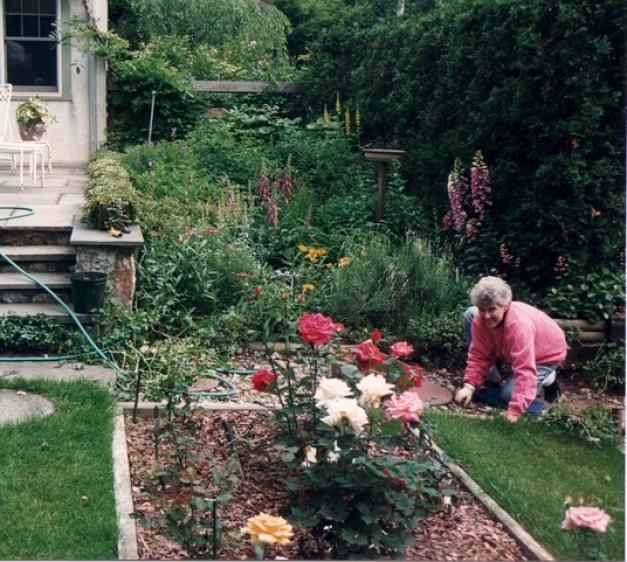By Alan Jaffe
I was the caregiver for my late wife Gail over the last five years of her life. I hope to share my experience with other caregivers and relate how changing my way of communicating helped us.
Gail worked for 40 years as a professional social worker and psychotherapist. After Gail retired in 2000, she gave 240 medical books to medical institutions. She was also an avid gardener, who maintained a perennial garden at our home in New York state. It contained one hundred roses, which bloomed every May and June. I remember people asking Gail if she was a master gardener.
In 2000, she noticed some mental problems interfering with her work and her life, and she began to seek out a neurologist. As we planned for many years, we moved from New York to Tucson, Arizona. Here she found a neurologist to evaluate her over time.

Alan and Gail , Utah, 2007. Courtesy, Alan Jaffe
Gail had always been active. She had an interest in pets and taking care of them. In 2001, Gail started daily horseback riding on a Lipizzaner Horse. She rode this horse for 10 years, and she loved every minute of it.
While Gail was horseback riding, I drew. In 2007, I started a new art hobby in photo realistic pencil drawings. I had one art show in Tucson in 2012.
For many years we traveled, taking advantage of being together while we could. Gail’s health eventually prevented us from traveling in 2014. Thinking of our future, we realized there were medical benefits of moving into assisted living.
In 2015, Gail was diagnosed with mild cognitive impairment and I noticed changes in her behavior. Yet, she made every effort to deal with the oncoming medical situation. She remained positive, and it was remarkable. I have evidence going back to 1998 of her preparing for the possibility and recognizing what could be done as she faced her mental challenges. Her awareness of this disease and her being active in making things happen helped us, as a couple, to deal with the slight changes occurring then.
Eventually, the neurologist diagnosed my wife with possible or probable Alzheimer’s disease. Her neurologist was confident that I would need help taking care of Gail.
Relearning how to talk

Alan and Gail, Nassau, 1969. Courtesy, Alan Jaffe
As a full-time caregiver, I recognized our relationship had changed. Her professional background had helped us to do the best we could under ever-changing medical conditions. But now, talking together was presenting a problem.
I could see her desire to do the things she has always loved. I tried to suggest things she might like to do. I would typically ask questions like this: “Do you want to go to Chico’s for a sweater? What would you like to have for lunch today? What are you reading?” These questions seemed to frustrate my wife. I didn’t recognize her. I think that questions put pressure on her to make a complex decision and led to anxiety and maybe fear and stress.
I wasn’t aware of the many mental steps she was going through to communicate what she had to do.
Conversations were leading to uncomfortable situations. For example, if I asked her “what clothes” she wanted to wear, she would change her mind many times. It was up to me to figure it out how to make things better. I had to relearn how to talk to my wife who I’ve known for 62 years.
I changed my way of talking. Instead of asking her questions, I would try and prompt her to share her thoughts. To help her choose her clothes, I said, “It is very warm outside right now, and I have on a lightweight shirt. She replied, “I have one too.”
Instead of saying, “Do you want to go buy new clothes? I would say, “I haven’t been with you to Chico’s in a while…” Gail would then come up with the idea of us going to Chicos. It was empowering.
Another time, when I wanted to ask if she’d like to take a walk, I changed the question into: “I see some of the cacti here are in bloom and I want to go out and take some pictures of them.” She then told me that she wanted to go out.
I realized that if I didn’t ask things as questions, she was able to do what she wanted, as she saw fit. She could get dressed and ready to go on her own terms. It seemed to be working on a small scale. I also noticed that we were able to be social with other people for short periods. She enjoyed short visits.
It was tiring to always be thinking of what and how to phrase things. But it was working. I didn’t mind getting tired. I had to be aware and just not ask a question. This “Don’t Ask” policy for me was working, and she was all in. If she was tired, she could say so. Now, I was not putting any pressure on her.
Everyone is different. Avoiding asking a loved one open-ended questions could be very helpful to many caregivers. It might be helpful to ask more yes/no questions. But for me, I avoided any sentence with a question mark.
After Gail died in 2018 at the age of 80, I moved to the Seattle area, and I volunteered in 2019 to help at the offices of the Alzheimer’s Association in Lynnwood, WA. It was wonderful to help them, and to share my experience.
It was there at the Alzheimer’s Association office that I was able to share this modest way of communicating in a small way. Maybe, one caregiver who sees this will find a modest way to make a change in communicating with their loved one. •
Helpful Alzheimer’s Association Resources:





